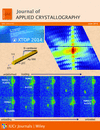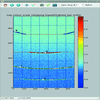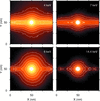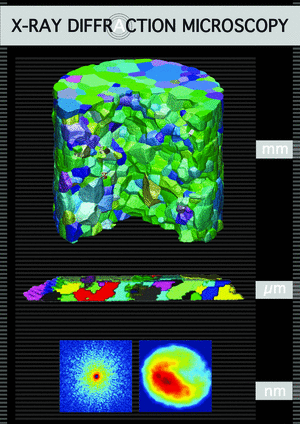issue contents
X-ray diffraction and imaging special issue (June 2015)
Guest Editor(s): Vincent Favre-Nicolin and Andras Borbely
Guest Co-editor(s): Jose Baruchel, Hubert Renevier and Joel Eymery
This virtual issue of Journal of Applied Crystallography represents some highlights of the 12th Biennial Conference on High-Resolution X-ray Diffraction and Imaging (XTOP). The issue collects together a series of articles originally published in the journal between February and June 2015.

Cover illustration: Visualization of the in situ three-point bending of an Au nanowire by micro Laue diffraction. Courtesy of Leclere et al. [J. Appl. Cryst. (2015), 48, 291–296].
Open  access
access
 access
accessThe latest virtual special issue of Journal of Applied Crystallography includes some highlights of the 12th Conference on High-Resolution X-ray Diffraction and Imaging (XTOP), which took place in Villard-de-Lans and Grenoble in September 2014.
Open  access
access
 access
accessX-ray diffraction-based structural analysis results of possible direct bandgap Si/Ge superlattices composed of monolayer thin deposits are presented, together with theoretical predictions and first optical measurements.
Open  access
access
 access
accessThe in situ three-point bending of a single self-suspended Au nanowire is visualized by micro Laue diffraction. The nanowire deflection is inferred from the displacement of Laue spots and it is well described by finite element analysis taking into account geometric nonlinearities and the elastic constants of bulk Au.
Open  access
access
 access
accessThrough micro Laue tomography analysis, the depth-resolved cartographies (i) of NiO grains in a solid oxide fuel cell sample and (ii) of the full tensor of the deviatoric strain into a slice of a Ge sample are obtained.
Open  access
access
 access
accessQuantitative X-ray phase contrast imaging uniquely offers quantitative imaging information in terms of electron density maps allowing for mass and mass density determinations of soft biological samples (`weighing with light'). Here, it was carried out using coherent X-ray waveguide illumination, yielding values of the mass and mass density of freeze-dried bacterial endospores (Bacillus spp.).
Open  access
access
 access
accessThis article details the geometry, peak-picking, calibration and integration procedures on multi- and many-core devices implemented in the Python library for high-performance azimuthal integration.
Open  access
access
 access
accessThe basis-forbidden Si 200 and Si 222 reflections are investigated in detail as a function of the in-plane sample orientation Φ and the divergence perpendicular to the diffraction plane of the used diffractometer. The results have important consequences for the detection of layer peaks near these reflections.
Open  access
access
 access
accessCrystal defects can be identified by their fingerprint in coherent X-ray diffraction patterns. Realistic defects in face-centred cubic nanocrystals are studied numerically, revealing various signatures in diffraction patterns depending on the Miller indices and providing an identification method.
Open  access
access
 access
accessRocking curve imaging (projection and section X-ray topography) has been used to study different kinds of defects such as precipitates, dislocations and twins in directionally solidified mono-like silicon ingots. The qualitative and quantitative information extracted from the reconstructed integrated intensity, FWHM and peak position maps provides clues about the initial stages of silicon growth.
Open  access
access
 access
accessThe generalization of the theoretical approach suggested by Kaganer et al. [Phys. Rev. B, (1997), 55, 1793–1810] to an arbitrary surface orientation, arbitrary dislocation line direction and noncoplanar measurement scheme was developed. It was applied to study the dislocation microstructure of Ge films on Si(011) and Si(111) based on a set of reciprocal space maps and profiles measured in noncoplanar geometry.
Open  access
access
 access
accessIt is demonstrated that crystals with curved diffracting planes made of relatively light elements, such as silicon, germanium and gallium arsenide, in the Laue diffraction geometry and in an energy range between 60 and 600 keV can reach a higher diffraction efficiency than more dense mosaic crystals such as copper, silver and gold. In particular, self-standing curved crystals can be used as elements in γ-ray lenses.
Open  access
access
 access
accessBoth optical microscopy with polarized light and polychromatic beam synchrotron X-ray diffraction imaging (white-beam topography) are used to study in situ the way an ice single-crystal deforms.
Open  access
access
 access
accessA method for the simulation of the diffractometer instrumental function for high-resolution X-ray diffraction, applicable for coplanar and noncoplanar measurement geometry and for any combination of X-ray optical elements, is proposed. Good agreement is demonstrated between the measured and the simulated reciprocal-space maps, which account for the instrumental function.
Open  access
access
 access
accessMonte Carlo simulation of the dose distribution in water around magnetite nanoparticles irradiated by monochromatic X-rays is presented.
Open  access
access
 access
accessStructural changes in vertebrate bone tissues caused by bone growth or by weightlessness were studied using a combination of X-ray tomography at different wavelengths and X-ray fluorescence analysis.
Open  access
access
 access
accessA laboratory X-ray diffraction setup is reported, which allows quantitative characterization of the microtwin and antiphase domain densities in epitaxial GaP/Si thin layers.


 journal menu
journal menu
































